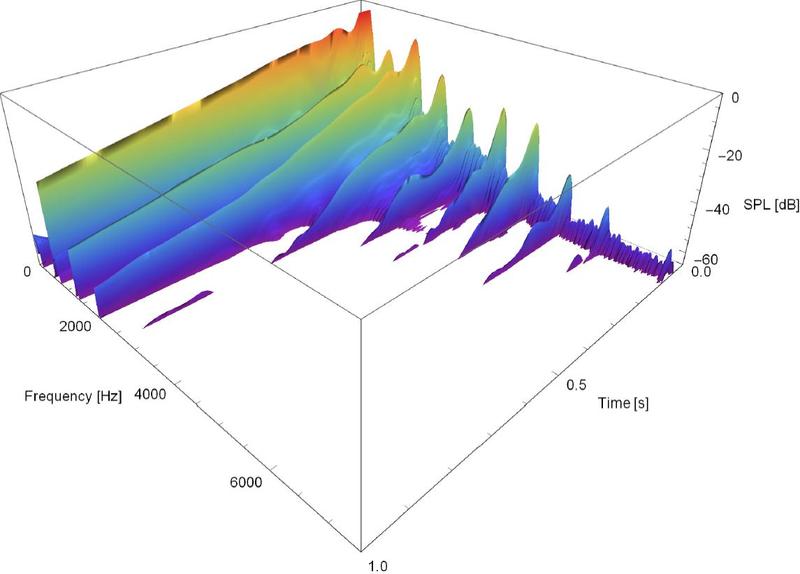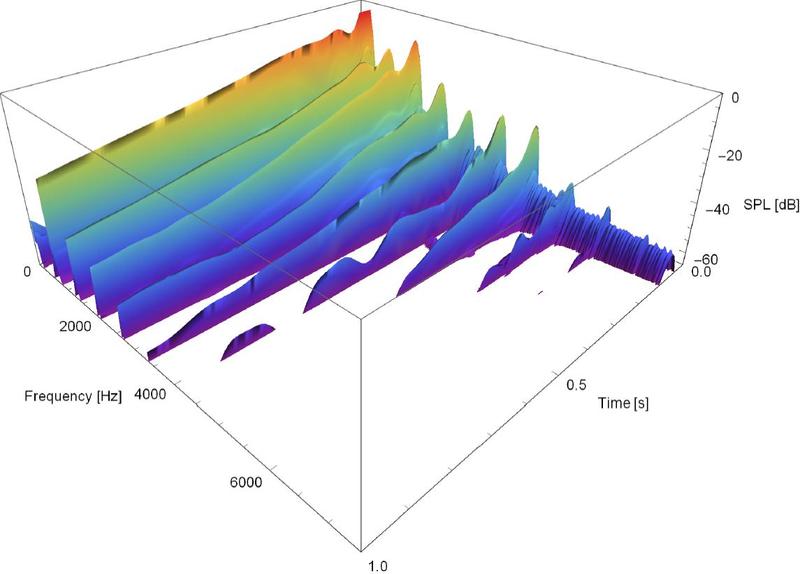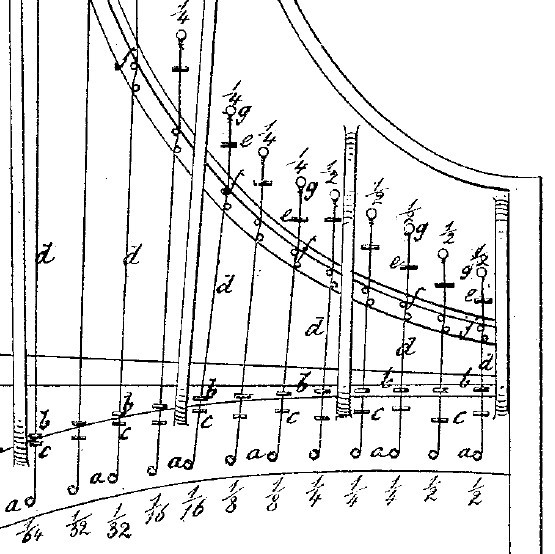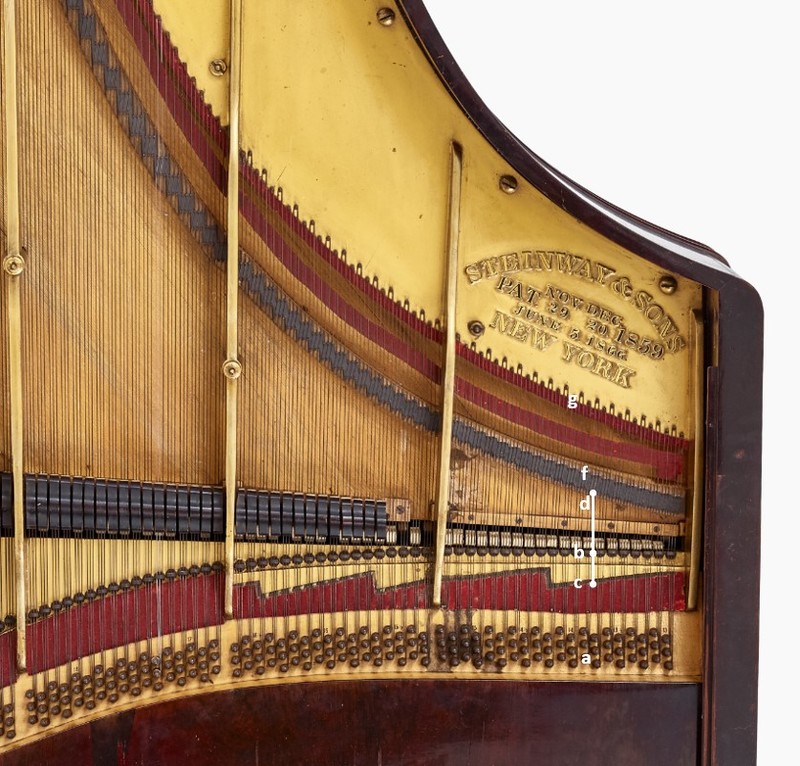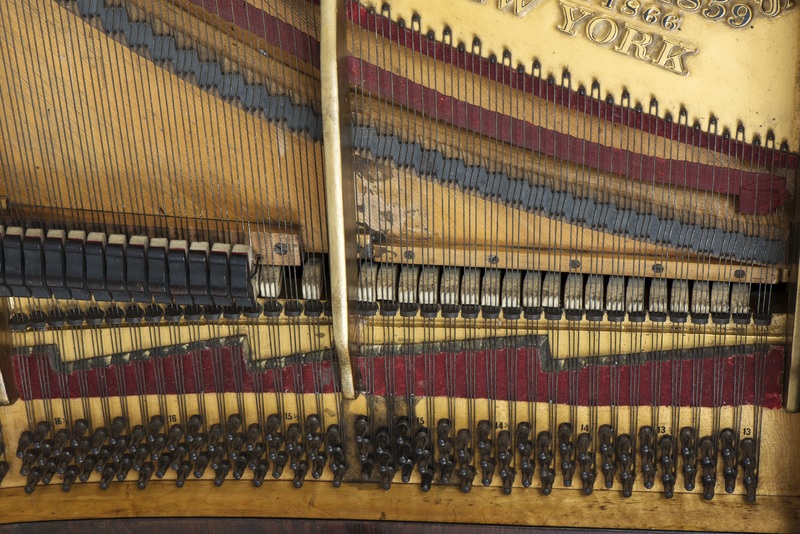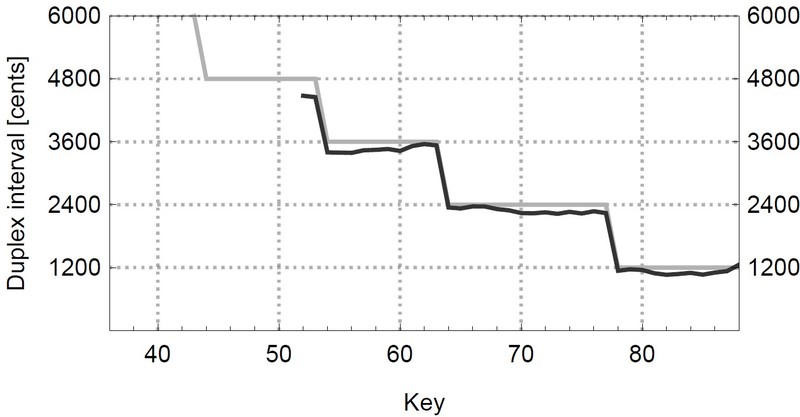The duplex scale
“This scale, which rests upon the scientific investigations of Helmholtz, is one of the most beautiful applications of science to art that our civilization has seen.”[1]
Few piano constructions have received such conflicting judgements on their effect and function as the duplex scale. From the beginning of their use, they were criticized as either ineffective or even tonally unfavorable. At the same time, the success of this scale is evidenced by the fact that it is still used by almost all piano companies today.[2] The claim that the invention was based on Helmholtz’s research has also caused admiration and doubt.
The string tension of grand pianos had risen a great deal during the 19th century in order to meet the demands of range and volume.[3] This was accompanied by fundamental changes in construction methods.[4]
One result of modern construction methods and the extension of the tonal range upwards was great stiffness of the treble strings, which produced a rather dull sound. The duplex scale was intended to remedy this problem.
On most stringed instruments, a string does not sound over its entire length, but only in the section between the bridge and the boundary near the pegs (depending on the instrument, this might be a nut, agraffe or capo). On grand pianos it was common practice to use felt strips to damp the parts of the strings outside of the sounding string length.
The main section of the string itself vibrates not only in its entire length, but also in its integer divisions (½, ⅓ , ¼ etc.).
In simple terms, this produces both the fundamental tone and the overtones, the mixture of which determines the timbre. Due to the above-mentioned stiffness and the short length of the treble strings, their overtones are too weak in relation to each other because the partial lengths are prevented from vibrating.
The idea behind the duplex scale is allowing the two previously unused outer sections of the string to resonate in order to enrich the sound. It seemed particularly advantageous if there was a proportional length between the main and the two secondary sections. In this case, the additional tones would coincide with and amplify the overtones of the main string – which had previously been too weak. In addition, the duplex scale extends the duration of the sound. Both effects can be clearly seen in the spectrogram. On the left, the two duplex string sections are first damped; on the right, they vibrate freely.
In May 1872, Theodore Steinway submitted a US patent for his most recent invention, which can be seen here. Patents are valuable sources because the inventors themselves comment on their motivation, functionality, and the presumed effect of their design. They often include technical drawings as well.
Patente sind wertvolle Quellen, weil sich die Erfinder selbst zur Motivation, angenommer Funktionsweise und Wirkung ihrer Konstruktion äußern und oft technische Zeichnungen beifügen.
On the left is a detailed illustration of the patent drawing. It shows the treble range of a grand piano, where the duplex scale is mainly used. The keyboard is not shown in the sketch; it would be found at the bottom. The duplex scale consists of two parts, the front one being fixed to the wrestplank and the rear one to the plate. The parts of the strings that had previously been completely damped by felt, were “exposed” here at the appropriate length. In the patent text, the design of the new support points that delimit the duplex sections, is paraphrased by the terms “secondary agraffe” and “support”.
a: Tuning pin
b: Agraffe
c: Front limit of the duplex scale
d: Sounding length of the string
e: Rear limit of the duplex scale
f: Outer bridge pin
g: Hitch pins
The fractions each indicate the ratio of the duplex length compared to the sounding length. This results in only octaves (1/2 denotes the first octave, 1/64 lies six octaves above the fundamental).
The first grand piano that was regularly equipped with the duplex scale bore the anniversary serial number 25,000. It stood in sales rooms at the end of April 1872, two weeks before the patent was granted.[5] Apart from those instruments that contained the duplex scale from the beginning, at least some older specimens seem to have been retrofitted. The case of the Helmholtz grand piano proves that Steinway employees themselves carried out this conversion. However, due to the small number of pianos of this period in public collections, it is not possible to determine exactly how often this was done.
But any subsequent installation was subject to practical restrictions. Because the hitch pins were very close to the edge of the plate, it was not possible to attach duplex supports at a useful position on the plate. This meant that the rear half had to be omitted. Helmholtz describes exactly this when he tells his wife in 1873:
“In the morning, Mr. Theodore Steinway appeared and wished to apply his latest improvement of the high strings [meaning the duplex scale] to our grand piano, at least as far as possible on an older instrument. On the part of the string that no longer resonates, that is, on the side of the keyboard between the peg and the agraffe, he has added a second bridge that separates sections of strings that add certain overtones to the whole string.” (-> Object Biography)
On the wrestplank, there was enough space for the front section. The strings rest on a “stair-shaped” base covered with felt. Only the area between the felt edge and the agraffe is exposed and can resonate with the main part of the string. The length of this part is precisely measured and amounts to a half, a quarter, an eighth or a sixteenth. This corresponds to the first, second, third and fourth octaves above the fundamental. In this respect, the duplex scale of the Helmholtz grand corresponds precisely with the patent.
In the letter written after the conversion (-> Object Biography) Helmholtz clearly describes the difference in sound that he perceived (“The high notes, which were previously somewhat dry, seem to have become fuller and more sonorous. [...] The highest tones of our instrument have gained a great deal; the difference is very evident when the released string sections are damped again”). Today, however, a comparison of the sound with or without damping the duplex sections is less clear. One possible explanation for this is that a clear frontal limitation of the duplex scale is currently missing from the Helmholtz grand piano. This function is fulfilled by a rather coarsely cut felt cover instead of the clear (metal) contact point found on modern grand pianos. In the past, something similar was probably used; Helmholtz writes in the above-cited quote about a “second bridge” that Theodore Steinway had inserted on the wrestplank.
The duplex sections are audible today at least from plucking. For the notes c3 and c5, a comparison is made here between the regularly struck fundamentals (left) and the corresponding plucked duplex tones (right):
[1] Morris Smith, Fanny: A Noble Art. Three Lectures on the Evolution and Construction of the Piano, New York 1892, p. 58.
[2] Öberg, Fredrik/Askenfelt, Anders: Acoustical and perceptual influence of duplex stringing in grand pianos, in: Journal of the Acoustical Society of America, 131/1 (2), Melville, New York 2012, pp. 856-871.
[3] Additional details on the technical development of pianos in Good, Edwin: Giraffes, Black Dragons, and Other Pianos. A Technological History from Cristofori to the Modern Concert Grand, Stanford 1982.
[4] Conklin Jr., Harold A.: Piano design factors - their influence on tone and acoustical performance, in: Anders Askenfelt (Hg.), Five lectures on the acoustics of the piano, Stockholm 1990, pp. 19-38.
[5] In the diary entry of William Steinway from April 27, 1872, he writes explicitly: “Grandpiano No 25,000 down in the Store since Yesterday With Duplex scale".
Citation: Katharina Preller, ‘“One of the most beautiful applications of science to art”? The Helmholtz grand piano by Steinway & Sons’, in: Materiality of Musical Instruments. A Virtual Exhibition.

